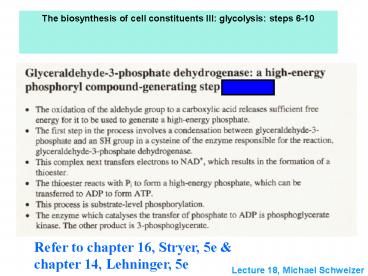Glycolysis - PowerPoint PPT Presentation
1 / 18
Title:
Glycolysis
Description:
The biosynthesis of cell constituents III: glycolysis: steps 6-10 Refer to chapter 16, Stryer, 5e & chapter 14, Lehninger, 5e Lecture 18, Michael Schweizer – PowerPoint PPT presentation
Number of Views:217
Avg rating:3.0/5.0
Title: Glycolysis
1
The biosynthesis of cell constituents III
glycolysis steps 6-10
Refer to chapter 16, Stryer, 5e chapter 14,
Lehninger, 5e
Lecture 18, Michael Schweizer
2
steps 6-10
Glycolysis continued. Recall that there are 2 GAP
per glucose.
3
6. Glyceraldehyde-3-phosphate dehydrogenase
catalyzes glyceraldehyde-3-P NAD Pi ??
1,3-bisphosphoglycerate
NADH H
4
(No Transcript)
5
GAP H2O NAD 3-PGA
DGo -12 kcal . mol-1 3-PGA Pi
1,3-bisPGA
DGo 12 kcal . mol-1 (1,3-bisPGA H2O
3-PGA Pi DGo
-11.8 kcal . mol-1) Participation of a common
intermediate 1,3-bis-PGA GAP NAD Pi
1,3-bisPGA NADHH DGo 1.5 kcal .
mol-1 (step 6) 1,3-bisPGA ADP 3-PG
ATP DGo -4.5 kcal . mol-1 (step 7) Sum of
the two reactions 3-GAP NAD Pi ADP
3-PGA NADH H ATP
DGo -3 kcal . mol-1
6
The aldehyde of glyceraldehyde-3-phosphate reacts
with the cysteine thiol to form a thiohemiacetal.
Oxidation to a carboxylic acid (in a
thioester) occurs, as NAD is reduced to NADH.
- The high energy acyl thioester is attacked by
Pi to yield the acyl phosphate (P) product.
7
Glycolysis
- Step 6
- Oxydation of an aldehyde to a carboxylic group,
releases sufficient DG to drive - NAD to NADH H and
- creates a (P)
- high energy bond
- (mixed anhydride)
- Oxidation of GAP yields substantial energy
- investment of (2P) at steps 1 3 can
- be returned
- with profit at steps 7 10.
1,3-bisphosphoglycerate (1,3-bisPG) DGo -11.8
kcal . mol--1
8
(No Transcript)
9
Glycolysis
- Step 7
- First substrate level phophorylation (energy from
oxydation of step 6)
10
steps 8-10
Refer to chapter 16, Stryer, 5e chapter 14,
Lehninger, 5e
11
8. Phosphoglycerate Mutase catalyzes
3-phosphoglycerate ?? 2-phosphoglycerate
Phosphate is shifted from the OH on C3 to the OH
on C2. An active site His participates in
phosphate transfer. The process involves a
2,3-bisphosphate intermediate Reposition of (P)
from C-atom No.3 to C-atom No.2.
12
9. Enolase catalyzes 2-phosphoglycerate ??
phosphoenolpyruvate H2O This Mg-dependent
dehydration reaction is inhibited by fluoride.
Fluorophosphate forms a complex with Mg at the
active site (creating by dehydration an
energy-rich enolic phosphate, DGo -14.8 kcal .
mol-1).
13
10. Pyruvate Kinase catalyzes
phosphoenolpyruvate ADP ? pyruvate ATP This
reaction is spontaneous. PEP has a larger DG of
phosphate hydrolysis than ATP. Removal of Pi from
PEP yields an unstable enol, which spontaneously
converts to the keto form of pyruvate. (DGo
(-6.8 (enolpyruvate) -8.0 kcal. mol-1
(tautomerisation)) -14.8 kcal . mol-1) One
would expect that the DGo for this reaction
would be -7,5 kcal. mol-1, but it is -6.1 kcal.
mol-1, but the equilibrium and therefore DGo
are so far to the right that it is difficult to
obtain an accurate value for Keq and DGo).
14
Glycolysis
- Step 10
- Second substrate level phosphorylation
- PEP is a high energy phosphate-containing
molecule the product pyruvate can isomerize
(pyruvate is capable of allowing electron
delocalisation enhanced resonance stabilisation
and tautomerization of product molecules) - Pyruvate end product of glycolysis
15
(No Transcript)
16
(No Transcript)
17
Glycolysis
- Glycolysis is the breakdown of glucose into
pyruvate. This process requires ADP and NAD as
co-factors. A cell can always find a way to
hydrolyse ATP back into ADP, but NAD is more
difficult as its formation involves oxydation of
NADH. Under anaerobic conditions another electron
acceptor is needed, under aerobic conditions the
electrons from NADH can ultimately passed onto
O2.
18
Refer to chapter 16, Stryer, 5e































